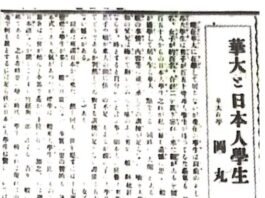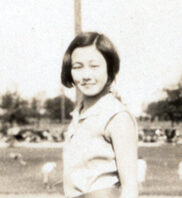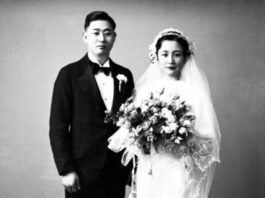History of Seattle Nikkei Immigrants from ‘The North American Times’
This series explores the history of the pre-war Japanese community in Seattle, by reviewing articles in “The North American Times,” which have been digitally archived by the University of Washington and Hokubei Hochi Foundation (hokubeihochi.org/digital-archive). Publication of this series is a joint project with discovernikkei.org.
By Ikuo Shinmasu
Translation by Yuta Ioriya For The North American Post
‘The North American Times’ was first printed on September 1, 1902, by publisher Kiyoshi Kumamoto from Kagoshima, Kyushu. At its peak, it had a daily circulation of about 9,000 copies, with correspondents in Spokane, Vancouver BC, Portland, San Francisco, Los Angeles, and Tokyo. When World War II started, Sumio Arima, the publisher at the time, was arrested by the FBI. The paper was discontinued on March 14, 1942, when the incarceration of Japanese American families began. After the war, the paper was revived as “The North American Post.”
Part 10 -3 Nisei Dual Citizenship and Marriage Issues (concluded)
Continued from July 28th Issue
Nisei Marriage Issues
In the 1930s, Nisei marriage became the most serious issue in the Japanese American (JA) community. Many meetings were held, mainly by the Japanese Association, to discuss how to resolve it.

“Marriage Roundtable” and “Sad Community Story of Marriageable-Age Girls Who Missed Opportunities”
(“North American Times,” Dec. 8 and 12, 1934)
On December 7, Chuzaburo Ito, Yoshitaro Fujihira, Shojuku Amano, Shinsaku Sawada, Sokichi Hoshide, Tadashi Yamaguchi (3), and others attended a roundtable discussion on the issue of Nisei marriage, hosted by the Social Affairs Department of the Japanese Chamber of Commerce (Nissho).
“When Mr. Fujihira, as the chairman, gathered statistics on the birth rate in the Japanese community through a survey at the time of the expansion of the Japanese school, it showed that births peaked between 1919 and 1920. Since then, births have been gradually declining, but those who were born then have already reached the ages of 16 or 17, and they are now majorities (of the local ethnic Japanese population). In other words, many women will reach marriageable age soon. … I heard that there are about 100 women of the ages 22 or 23 in the Seattle and Tacoma areas. About a year ago, there was a meetup for marriageable-age youth in California and about 30 men joined the event; but there were no female participants despite their being invited as well. Although most of the male participants were Kibei, many women considered American-born men as undesirable spouses because they were too “Yankee” to marry. Also, they thought those men tended to want a girl who could accept all of their demands.
“In modern society, people consider the ideal marriage age for females as between 22 and 23; for males, it is 30 years old. Considering this as the norm, the numbers of marriageable-age males and females in our community look appropriate if people of the same age marry; but there are considerable problems for girls born in the transition period (1919-1920). This is where our social difficulty arises.”
 “Hokubei Nenkan” (The North American Almanac) in 1936 lists the Nisei population in Seattle by age. The data appear to be the actual numbers in 1934 and almost match the data from the above article.
“Hokubei Nenkan” (The North American Almanac) in 1936 lists the Nisei population in Seattle by age. The data appear to be the actual numbers in 1934 and almost match the data from the above article.
If we extrapolate from the 1936 data to the number of marriageable-age youth — females aged 20 to 24 and males aged 28 to 32 — in 1940, we can see that women overwhelmingly outnumbered men (table).
Sumiyoshi Arima, in his column “Hokubei Shunju,” wrote the following about Nisei women marriages.
“Nisei Women Marriages in Japan”
(NAT, Jan. 20, 1939)
“There is an opinion that sending Nisei to Japan is one way to solve the marriage problem of Nisei women. This isn’t a good idea and in fact, it’s not really feasible. Marriage in Japan isn’t as easy as in the United States. In Japan, there is an age limit for women to get married; they consider women aged 23 – 24 as too old to marry. Therefore, it would be much harder for a Nisei woman who is almost 30 years old to find a suitable spouse in Japan. Even if she does find a partner, it might be a second marriage for him. …
“After all, Nisei women, for better or worse, are American girls; psychological, educational, and conventional differences with boys from Japan never bring happiness to either of them. …
“In terms of life, I think the United States is probably the happiest place for Nisei women. However, the difficulty in older girls marrying is a real problem. It cannot be solved no matter how they think about it unless they find partners by themselves. If we left this issue unsolved, there could be a huge risk for us to face various social problems.
Therefore, I think it would be wise for Nisei women themselves to be aware of their own status and circumstances, and for their parents to face reality and compromise where appropriate. A woman, after all, finds her happiness in marriage.”
Marriage Between Nisei
The “North American Times” frequently published stories of engagements between Nisei men and women and their weddings from 1938 to 1942. Here, I would like to introduce articles about such marriages in the midst of societal tension during the war in 1942.
The January 21, 1942 issue shared a story of an engagement between Nisei in Seattle with the names of the bride and groom, as well as of the matchmakers, to celebrate the marriage. It mentioned that the groom happily enlisted in the United States Army. (4)
The January 27th issue of the same year featured the engagements of two Nisei couples in Seattle. The February 5th issue featured a marriage of one additional Nisei couple. (5)
Furthermore, the issue of February 16th, just before the order of JA incarceration (6), ran the story of Fumiko, the third daughter of Chiyokichi Natsuhara, the owner of Natsuhara Company, Auburn, who was considered an influential senior community leader. She exchanged betrothal gifts with Joji, the eldest son of Yasukichi Iwasaki, a wealthy farmer living in Hillsboro, Oregon. Their wedding was to be held at the Oregon Buddhist Church in the near future.
Looking at these articles, I feel that Nisei marriages during the war gave strong confidence and pride to JAs to survive in the United States.
Although many Nisei were caught between Japan and the United States and suffered from the issues of dual nationality and marriage, they faced a tremendous challenge with the earnest support of the Issei and their own efforts. Through marrying, they contributed to the development of JA society in the future.
In the next chapter, I would like to introduce articles about the universities in which Nisei enrolled.
Editor’s notes.
(1) Accompanying notes from NAP proofreader Geraldine Shu: “Here are my aunt & uncle in their wedding photo. I know they got married right before going to camp so they wouldn’t get separated. My aunt had just turned 23 and my uncle was 28 (b. Nov 1913).”
(2) A more comprehensive table is in Shinmasu, https://discovernikkei.org/en/journal/2023/6/12/north-american-times-13-pt2/
(3) Tadashi Yamaguchi is NAP-editor David’s grandfather. In attending community meetings on Nisei marriage, undoubtedly his thoughts were on his headstrong daughter, Natsuko, born in 2020.
(4) The Kibei groom, Minoru Miyake, is not listed on the WWII MIS Registry, the most likely path for Kibei to join the US Army (java.wildapricot.org; there, click on Research, then “MIS language school registry”). Thus, he might have been missed during registry compilation. Alternatively, he could have enlisted before the Pearl Harbor bombing and was regular army. Most Seattle Nisei would not again be eligible for enlistment until 442nd-infantry recruiters showed up at the Minidoka camp, Idaho, in February 1943.
(5) In late January, Seattle newspapers were discussing ethnic Japanese exclusion from the West Coast: “Let’s move the West Coast Japs inland…” (“Seattle Star,” Jan. 15); “Herd ’em up, pack ’em off…” (“Seattle Times,” Jan. 30). In this context, some dating Nisei couples married early to ensure they would not be separated during the war.
(6) Executive Order 9066 was announced February 19.
Ikuo Shinmasu retired in 2015 from Air Liquide Japan Ltd., then researched his grandfather who migrated to Seattle. He shared his findings through the series, “Yoemon Shinmasu – My Grandfather’s Life in Seattle,” in the NAP and in “Discover Nikkei” in Japanese and English during 2019-2020. He lives in Zushi, Kanagawa, with his wife and son.
Yuta Ioriya is a freelance translator for “Discover Nikkei.”



